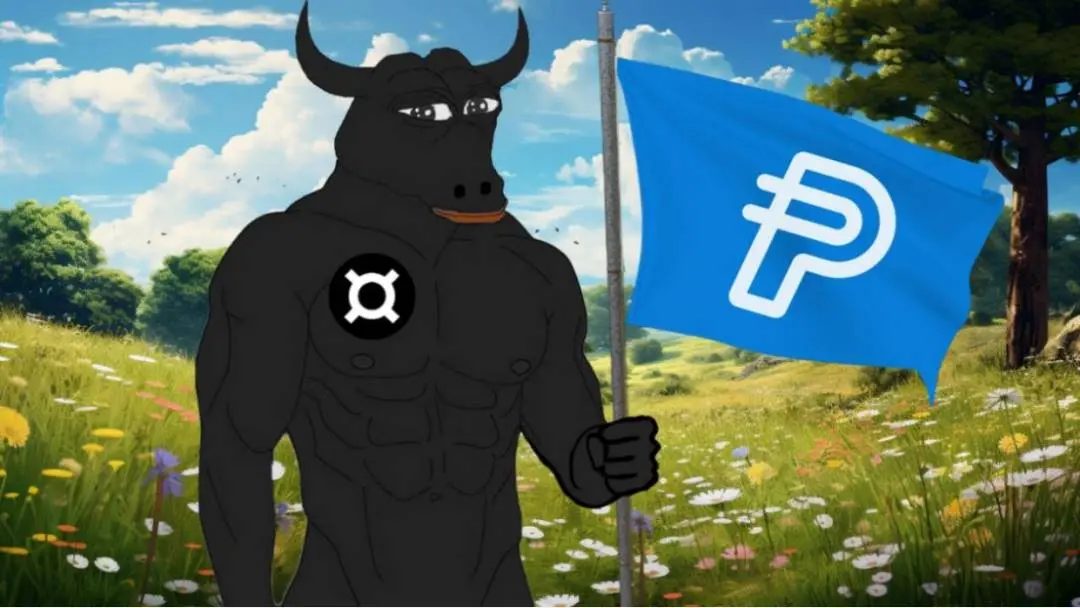Analyzing the intrinsic logic of Paypal stablecoin payments and the evolutionary approach towards mass adoption
Author: Will A-Wang
On May 31, 2024, PayPal announced the launch of its stablecoin PayPal USD (PYUSD) on the Solana blockchain. This marks another significant milestone following the initial launch of PYUSD on the Ethereum mainnet last August, providing users with a new and efficient payment method and offering important insights into the future trends of the payment industry.
In the process of writing the Web3 Payment Research Report and discussing with industry companies, I have been pondering a question: Is stablecoin payment really necessary? Coincidentally, with the launch of PYUSD on Solana, PayPal provided a pragmatic answer regarding payment freedom:
"People want to pay freely, and the current payment networks struggle to meet that demand. Crypto can meet that demand and is practical, so as a fintech company committed to promoting payment innovation, we are launching a stablecoin payment solution to satisfy people's current desire for unrestricted payments."
Thus, this article will attempt to analyze the intrinsic logic behind PayPal's shift towards Crypto, the stablecoin payment solution launched with PYUSD on Solana, and the evolutionary ideas for PYUSD's path towards mass adoption. I hope this can provide reference for the industry and welcome discussions.
1. Why PayPal is Turning to Crypto
As a leading global payment company, PayPal has over twenty years of experience in global payments. During these two decades, alongside the mature development of e-commerce, PayPal has not only established itself as a trusted beacon, providing users with transaction trust, but has also achieved the widespread application of the internet digital payment network.
PayPal's original intention has remained unchanged—promoting payment innovation and allowing everyone to pay according to their wishes.
However, to date, payment innovation has been built on the same foundational financial tracks as when the internet first emerged. Although the industry has been striving to provide global, instant, and seamless transactions, reality often reveals shortcomings:
The settlement time for online payments is still long (averaging 2-3 days in the U.S.), and markets, banks, and service providers need to operate on business days, further extending settlement times; employers find it difficult to pay an increasingly distributed workforce; a growing global population struggles to make cross-border remittances in a cheap and efficient manner; businesses feel this friction the most, while consumers still wait long in payment environments they believe should be quick.
In short, people today cannot pay in the way they want.
This is why PayPal is turning its attention to Crypto; the answer is simple: it meets the demand and is practical.
Cryptocurrency and blockchain technology can bring people closer to realizing their payment desires: fast, cheap, global payments. This new generation of financial/payment infrastructure can help PayPal better serve its 40 million users, allowing everyone to pay according to their wishes.
Therefore, more than a decade after the emergence of cryptocurrency and blockchain technology, PayPal has once again arrived at a critical moment in payment history, a moment filled with potential and opportunity, much like the early 2000s internet.
Just as PayPal previously brought payments online, it is now bringing payments on-chain.

(flywheeldefi.com/article/paypal-steps-on-chain-with-pyusd)
2. Global Payment Dilemmas Await Improvement
Current payment channels and information transmission protocols (such as ACH, SEPA, and SWIFT) constitute the network of global payments. They enable us to conduct large-scale transactions across regions and time zones while ensuring relative smoothness in payments. However, the current payment technologies also force us to make trade-offs between 1) payment settlement speed and 2) cost-effectiveness, for example:
The flow of funds incurs costs, and there needs to be prior cooperation arrangements and liquidity requirements among various intermediaries;
The operating hours (business days) and batch processing across time zones mean payments may need to wait several days for settlement;
Net settlement arrangements struggle to meet the needs of small, high-frequency transactions.
However, for adults, we do not make choices; we want both—that is, efficient settlement at low cost.
What people want is to pay more easily. Businesses want to pay suppliers without worrying about settlement times; individuals want to remit money to distant family members without incurring high fees and waiting days. Today's financial infrastructure cannot quickly meet people's needs for fast transactions, and PayPal does not want users to lose value in this waiting.
Today, cryptocurrency and blockchain technology provide a new payment channel that can simplify the payment settlement process, making payments fast, cheap, and easily accessible.
Thus, we need to leverage cryptocurrency and blockchain payment technology solutions to address the legacy issues of traditional payments: 1) slow settlement times; 2) high transaction costs; and 3) incompatibility with regions currently underserved by the financial system (Under-banked and Unbanked).
3. PayPal's Stablecoin Payment Solution
(The Stablecoin from Payment Giant PayPal is Expected to Lead the Crypto Industry to the Mainstream)
Definition of Stablecoin: Most cryptocurrencies experience significant price volatility and are not suitable for payments, just like Bitcoin can have large fluctuations within a single day. A stablecoin is a type of cryptocurrency designed to address this issue by maintaining a stable value, usually pegged 1:1 to a fiat currency (such as the U.S. dollar). Stablecoins offer the best of both worlds: they maintain low daily volatility while providing the advantages of blockchain—efficient, economical, and globally applicable.
The stablecoin PYUSD launched by PayPal is a brand-new stablecoin payment solution aimed at achieving the next generation of fintech innovation. PYUSD is built on PayPal's deep accumulation in the payment industry and the high-performance Solana blockchain, enabling efficient instant settlement, reducing transaction costs, and ensuring high security and true global payments.
PYUSD is a stable value storage tool (1:1 dollar exchange) established on the blockchain by PayPal, and its emergence will address the aforementioned issues in the current global payment industry. Eligible U.S. users can buy, sell, send, and receive PYUSD and use it for payments:
Purchase and transfer PYUSD within the PayPal and Venmo ecosystem for a seamless deposit and withdrawal experience;
Use PYUSD as a payment method for online transactions, such as checking out and paying at millions of PayPal merchants globally;
Cross-border P2P payments with PYUSD on Xoom (cross-border payment tool);
Outside the PayPal ecosystem, PYUSD can be used on cryptocurrency exchanges (e.g., Crypto.com) and wallets (e.g., Phantom);
PYUSD can also be used for various innovations, such as serving as a fast, low-cost financing tool for ventures like Mesh.
PYUSD is building a truly stablecoin commercial scenario, providing a nearly frictionless and trustworthy payment experience expected by mainstream consumers and merchants.

4. The Evolutionary Ideas for PYUSD Stablecoin Payments Towards Mass Adoption
Based on PayPal's nearly 20 years of global payment compliance experience and the highest compliance standards of PYUSD, the combination of PayPal + PYUSD can upgrade previous stablecoin transactions to become the stablecoin payments we truly need.
When PayPal was founded, its responsibility was not only to promote payment implementation but also to introduce and disseminate a new technology—digital payments, which have now become ubiquitous in our lives. This successful experience can provide guidance and novel insights for the launch of PYUSD stablecoin payments. Specifically, PayPal divides the evolutionary ideas for mass adoption into three stages:
Awareness;
Utility;
Ubiquity.
4.1 Awareness through Introduction
As mentioned earlier, payments are ubiquitous and deeply rooted in habits and practices, so the transition needs to be gradual and stable; it will not happen overnight. Introducing a new payment method is both a behavioral change and a technological or financial shift.
The first step towards mass adoption is awareness—simply introducing people to the existence of new technology.
In this stage, early adopters are the target audience, namely cryptocurrency holders—this group accounts for about 15% of the global population and is relatively easy to reach. This is also the reason why PayPal launched PYUSD on Ethereum at the end of 2023, ensuring the awakening of awareness among early adopters.
Now, launching PYUSD on the second-largest market cap Solana high-performance blockchain can cover the most active and engaged groups in the crypto ecosystem, letting the world know, "PYUSD is really here."
Moreover, the integration of PYUSD with PayPal and Venmo applications will introduce it to over 100 million U.S. users. In the future, PayPal will continue to expand PYUSD's influence outside the PayPal ecosystem in collaboration with cryptocurrency exchanges and payment partners.
PayPal knows from its previous successful experiences that the cognitive awakening of a new payment mechanism is a necessary first step to enter the public consciousness.
4.2 Utility through Integration
The next step in adopting new payment technology is to achieve payment utility, which means transforming the initial cognitive awareness into actual payment utility in daily life, just as PayPal early on built itself into a platform providing trusted transactions between parties who did not know each other through eBay.
Today, the payments people need must be fast and cheap. While launching PYUSD on the Ethereum mainnet provided significant visibility, it did not fully meet all the standards required for PYUSD to fulfill its mission as a digital commerce payment tool—efficient, economical, and globally applicable.
Therefore, PYUSD turns to Solana to achieve payment utility.

(PayPal Launches Solana-Based Dollar Stablecoin: A New Chapter in Blockchain Payments)
Solana is a high-performance blockchain network built for finance, payments, loyalty programs, and more, and is one of the most widely adopted blockchains. In the fourth quarter of 2023, it processed an average of 40.7 million transactions daily, with 2,500 developers active in its ecosystem. Additionally, its open-source, programmable, and composable blockchain offers significant space and network effects.
Solana brings PYUSD much faster settlement speeds, lower transaction costs, stronger scalability, and global network support than other blockchains. With the advantages of Solana combined, users can truly realize payment utility when using PYUSD:
Real-time settlement: Most PYUSD transactions achieve efficient settlement within seconds;
Low transaction costs: Transaction costs on the Solana chain are only a few cents, regardless of the transaction amount;
Transaction finality: Merchants do not have to worry about customers canceling payments due to insufficient funds or other reasons;
24/7 availability: Available 7/24/365;
Interoperability: PYUSD can be used outside the PayPal ecosystem, achieving interoperability with other gateways, networks, and wallets;
Programmability and composability: PYUSD is developed on the widely adopted SPL token standard. This means any product supporting this standard will automatically support PYUSD. Developers can freely experiment and build within and outside the PayPal ecosystem. Consumers, merchants, and institutions can enjoy a wide range of third-party developer experiences, leveraging PYUSD for payment and financial use cases;
PayPal's large user base: PYUSD is available for existing eligible U.S. PayPal customers.
Thus, launching PYUSD on Solana will help with the long-term adoption of stablecoin payments. In this process, PYUSD will transition from the awareness stage to the actual payment utility stage.
With PYUSD launched on both Ethereum and Solana, it will attract more developers and ecosystem partners, and combined with the practicality on PayPal and Venmo applications, PYUSD will provide users with more practical and user-friendly use cases.
4.3 Ubiquity through Assimilation
The final stage of adopting any new payment technology is ubiquity, characterized by the seamless integration of technology into daily life. In this stage, people can effortlessly use the new payment technology without even noticing it—they simply pay at will.
For PayPal, it has made digital payments a way for people in over 200 countries to transfer money to each other and between businesses, serving as a secure, reliable, and standardized P2P, B2B, and B2C payment method that has become ubiquitous with the development of digital globalization.
5. Use Cases for PYUSD Stablecoin Payments on Solana
Turning dreams into reality and allowing people to pay freely cannot be achieved by mere slogans. Let's take a look at some of the practical scenarios for PYUSD.

5.1 Cross-Border Peer-to-Peer Remittances (P2P)
Today, personal economic connections across the globe are closer than ever. However, the cross-border transfer of funds between individuals is a vast and growing market full of opportunities. Remittances to low- and middle-income countries reached $669 billion in 2023 (World Bank data), but cross-border remittances are not cheap.
Using PYUSD, payers can directly remit to recipients using a Solana wallet, with transfers settling almost instantly and at nearly zero cost.
Even for recipients without a Solana wallet, payers can collaborate with payment service providers using PYUSD to save on the costs of cross-border remittance services. Payment service providers connect the fiat cash network through local partner banks of PYUSD, allowing recipients to easily convert PYUSD into bank deposits or cash, thus enjoying near-instant, low-cost global remittance services.
5.2 Inter-Business Transfers (B2B)
Due to the complexity of cross-border payments, there are multiple intermediaries and networks of correspondent banks, causing most B2B payments to take several days to settle. Moreover, depending on the method of cross-border fund transfer, payment fees can be quite high.
By leveraging the programmable features of PYUSD, businesses can build their own services, seamlessly creating nearly instant and cost-effective cross-border transfer methods, with relatively low technical requirements. Teams can also create smart contracts to manage the flow of PYUSD between accounts, enhancing the speed and accuracy of vendor payments (or any other B2B payments governed by contractual agreements).
Additionally, using PYUSD for transfers does not necessarily require businesses to hold PYUSD or even interact with it. Payment service providers can build B2B payment products that offer a fiat experience to end-users.
5.3 Global Payments (B2C)
PYUSD can significantly reduce the complexity of global payments. PYUSD does not need to go through complex networks (including unique regional bank accounts, different currencies, correspondent banks, and digital wallet tracks) but can be paid to any compatible wallet address. Furthermore, programmable smart contracts using PYUSD can enable business payers to automate payment processes more effectively, even allowing for real-time wage payments.
5.4 Microtransactions
Due to high transaction fees, traditional payment processing systems struggle to support microtransactions. Therefore, platforms handling microtransactions often batch payments, which involves complex payment engineering, increases risks, and prevents platforms from accepting microtransactions.
However, PYUSD on Solana will enable merchant platforms to easily process microtransactions in near real-time and at low cost. Microtransactions support various use cases, such as tips, in-game purchases, and paying small amounts to content creators per read or view.
5.5 Web3 Payments
Many Web3 merchants (such as NFT marketplaces and blockchain-based gaming platforms) lack connections to traditional fiat bank accounts and require robust, non-volatile payment solutions, which PYUSD + PayPal can provide.
6. Conclusion
Jose Fernandez da Ponte, Senior Vice President of PayPal's Blockchain, Cryptocurrency, and Digital Currency Group, stated: "The creation of PayPal USD aims to revolutionize commerce once again by providing a fast, simple, and cheap payment method for the next evolution of the digital economy. Offering PYUSD on the Solana blockchain further realizes our goal of creating a digital currency with stable value designed specifically for commerce and payments."
We can see that since PYUSD's launch on Ethereum last year, it has been relatively quiet, mostly operating within PayPal's Super App. With this launch on Solana, whether aiming to break out or further explore, there is no doubt that the killer application of Web3 may have arrived, and it is payments!
As we previously discussed in the Web3 Payment Research Report: The greatest opportunity for cryptocurrency may not be to view it as cryptocurrency, but rather as a new payment method.
Payments carry the significant mission of bridging the on-chain cryptocurrency system with the off-chain fiat currency system, and after the tokenization transformation through blockchain technology, it will endow the traditional currency system with new value, overcoming previously insurmountable boundaries, potentially forever changing the world economy.











